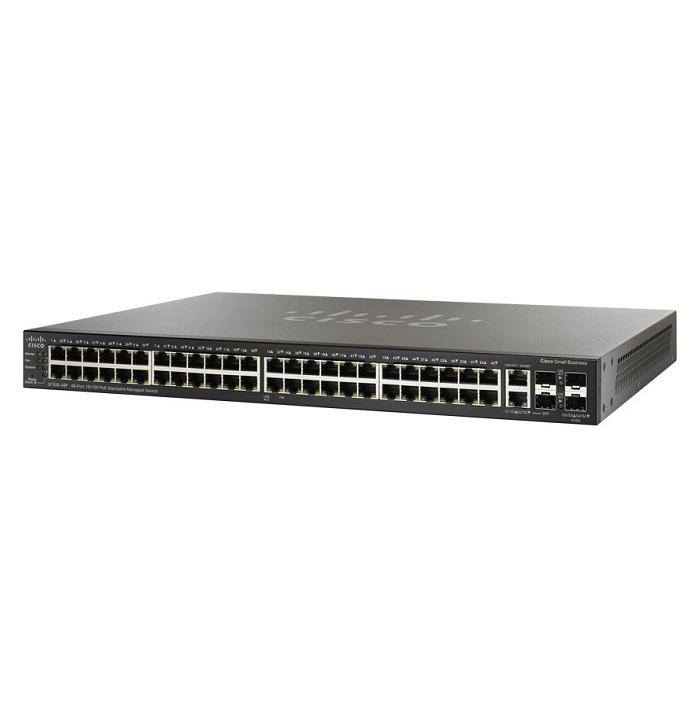48-port 10/100 PoE Stackable Managed Switch Cisco SF500-48P-K9-G5
- 48-port 10/100 PoE Stackable Managed Switch w/Gig Uplinks.
- Simple-to-use graphical interfaces reduce the time required to deploy, troubleshoot, and manage the network and allow you to support sophisticated capabilities without increasing IT head count.
- The switches also support Textview, a full command-line interface (CLI) option for partners that prefer it.
- Using Auto Smartports intelligence, the switch can detect a network device connected to any port and automatically configure the optimal security, quality of service (QoS), and availability on that port.
- Cisco Discovery Protocol (CDP) discovers Cisco devices and allows devices to share critical configuration information, simplifying network setup and integration.
- Support for Simple Network Management Protocol (SNMP) allows you to set up and manage your switches and other Cisco devices remotely from a network management station, improving IT workflow and mass configurations.
Specifications
| Performance | |
| Capacity in mpps (64-byte packets) | 13.1 |
| Switching Capacity (Gbps) | 33.6 |
| Power over Ethernet (PoE) | |
| Power Dedicated to PoE | 375W |
| Number of Ports That Support PoE | 48 |
| Layer 2 Switching | |
| Spanning Tree Protocol | Standard 802.1d Spanning Tree Support Fast convergence using 802.1w (Rapid Spanning Tree [RSTP]), enabled by default Multiple spanning tree instances using 802.1s (MSTP). 16 instances are supported |
| Port grouping/link aggregation | Support for IEEE 802.3ad Link Aggregation Control Protocol (LACP) Up to 32 groups Up to 8 ports per group with 16 candidate ports for each (dynamic) 802.3ad LAG |
| VLAN | Support for up to 4096 VLANs simultaneously Port-based and 802.1Q tag-based VLANs MAC-based VLAN Management VLAN PVE (Private VLAN Edge), also known as Protected Port, with multiple uplinks Guest VLAN Unauthenticated VLAN Protocol-based VLAN CPE VLAN Dynamic VLAN assignment via Radius server along with 802.1x client authentication |
| Voice VLAN | Voice traffic is automatically assigned to a voice-specific VLAN and treated with appropriate levels of QoS. Auto voice capabilities deliver network-wide zero touch deployment of voice endpoints and call control devices. |
| Multicast TV VLAN | Multicast TV VLAN allows the single multicast VLAN to be shared in the network while subscribers remain in separate VLANs. This feature is also known as Multicast VLAN Registration (MVR). |
| Q-in-Q | VLANs transparently cross over a service provider network while isolating traffic among customers. |
| GVRP/GARP | Generic VLAN Registration Protocol (GVRP) and Generic Attribute Registration Protocol (GARP) enable automatic propagation and configuration of VLANs in a bridged domain. |
| Unidirectional Link Detection (UDLD) | UDLD monitors physical connection to detect unidirectional links caused by incorrect wiring or port faults to prevent forwarding loops and blackholing of traffic in switched networks |
| DHCP Relay at Layer 2 | Relay of DHCP traffic to DHCP server in a different VLAN. Works with DHCP Option 82. |
| IGMP (versions 1, 2, and 3) snooping | Internet Group Management Protocol (IGMP) limits bandwidth-intensive multicast traffic to only the requesters; supports 1K (1024) and 4K (for SG500X in native mode) multicast groups (source-specific multicasting is also supported). |
| IGMP querier | IGMP querier is used to support a Layer 2 multicast domain of snooping switches in the absence of a multicast router |
| HOL blocking | Head-of-line (HOL) blocking. |
| Jumbo Frames | Frames up to 9K (9216) bytes in length. |
| Layer 3 | |
| IPv4 routing | Wirespeed routing of IPv4 packets Up to 2K (2048) static routes and up to 256 IP interfaces |
| Wirespeed IPv6 Static Routing | Up to 2K (2048) static routes and up to 128 IPv6 interfaces |
| Layer 3 Interface | Configuration of layer 3 interface on physical port, LAG, VLAN interface or Loopback interface |
| CIDR | Support for Classless Inter-Domain Routing |
| RIP v2 (on 500X) | Support for Routing Information Protocol version 2, for dynamic routing |
| VRRP (on 500X) | Virtual Router Redundancy Protocol (VRRP) delivers improved availability in a Layer 3 network by providing redundancy of the default gateway servicing hosts on the network. VRRP versions 2 and 3 are supported. Up to 255 virtual routers are supported. |
| DHCP Server | Switch functions as an IPv4 DHCP Server serving IP addresses for multiple DHCP pools/scopes Support for DHCP options |
| DHCP Relay at Layer 3 | Relay of DHCP traffic across IP domains. |
| User Datagram Protocol (UDP) Relay | Relay of broadcast information across Layer 3 domains for application discovery or relaying of BOOTP/DHCP packets. |
| Stacking | |
| Hardware stack | Up to 8 units in a stack. Up to 416 ports managed as a single system with hardware failover. |
| High availability | Fast stack failover delivers minimal traffic loss. |
| Plug-and-play stacking configuration/management | Master/backup for resilient stack control Auto-numbering Hot swap of units in stack Ring and chain stacking options Auto stacking port speed Flexible stacking port options |
| High-speed stack interconnects | Cost-effective 5G copper and high-speed 10G Fiber and Copper interfaces. |
| Hybrid stack | A mix of SF500, SG500, and SG500X in the same stack (10/100, Gigabit, and 10 Gigabit). |
| Security | |
| SSH | SSH is a secure replacement for Telnet traffic. SCP also uses SSH. SSH versions 1 and 2 are supported. |
| SSL | Secure Sockets Layer (SSL) encrypts all HTTPS traffic, allowing secure access to the browser-based management GUI in the switch. |
| IEEE 802.1X (Authenticator role) | RADIUS authentication and accounting, MD5 hash, guest VLAN, unauthenticated VLAN, single/multiple host mode and single/multiple sessions Supports time-based 802.1X Dynamic VLAN assignment |
| Secure Core Technology (SCT) | Ensures that the switch will receive and process management and protocol traffic no matter how much traffic is received. |
| Secure Sensitive Data (SSD) | A mechanism to manage sensitive data (such as passwords, keys, etc.) securely on the switch, populating this data to other devices, and secure autoconfig. Access to view the sensitive data as plaintext or encrypted is provided according to the user configured access level and the access method of the user. |
| Port security | Ability to lock Source MAC addresses to ports, and limit the number of learned MAC addresses. |
| RADIUS/TACACS+ | Supports RADIUS and TACACS authentication. Switch functions as a client. |
| Storm control | Broadcast, multicast, and unknown unicast. |
| DoS prevention | Denial-of-Service (DoS) attack prevention. |
| Multiple user privilege levels in CLI | Levels 1, 7, and 15 privilege levels. |
| ACLs | Support for up to 2K (2048) rules on 500 Series and 3K (3072) on 500X series. Drop or rate limit based on source and destination MAC, VLAN ID or IP address, protocol, port, DSCP/IP precedence, TCP/User Datagram Protocol (UDP) source and destination ports, 802.1p priority, Ethernet type, Internet Control Message Protocol (ICMP) packets, Internet Group Management Protocol (IGMP) packets, TCP flag. Time-based ACLs supported. |
| Quality of Service | |
| Priority levels | 8 hardware queues |
| Scheduling | Strict Priority and weighted round-robin (WRR) |
| Class of service | Port based; 802.1p VLAN priority based; IPv4/v6 IP precedence/ToS/DSCP based; DiffServ; classification and re-marking ACLs, Trusted QoS Queue assignment based on differentiated services code point (DSCP) and class of service (802.1p/CoS) |
| Rate limiting | Ingress policer; egress shaping and ingress rate control; per VLAN, per port, and flow based |
| Congestion avoidance | A TCP congestion avoidance algorithm is required to minimize and prevent global TCP loss synchronization |
| General | |
| Jumbo frames | Frame sizes up to 9K (9216) bytes. Supported on 10/100 and Gigabit Ethernet interfaces. The default MTU is 2K. |
| MAC table | 16K (16384) MAC addresses. |
| Discovery | |
| Bonjour | The switch advertises itself using the Bonjour protocol. |
| LLDP (802.1ab) with LLDP- MED extensions | Link Layer Discovery Protocol (LLDP) allows the switch to advertise its identification, configuration, and capabilities to neighboring devices that store the data in a MIB. LLDP-MED is an enhancement to LLDP that adds the extensions needed for IP phones. |
| Cisco Discovery Protocol (CDP) | The switch advertises itself using the Cisco Discovery Protocol (CDP). It also learns the connected device and its characteristics via CDP. |
| Power consumption (worst case) | |
| Green Power (mode) | Energy Detect |
| System Power Consumption | 110V=46.8W 220V=47.5W |
| Power Consumption (with PoE) | 110V=437W 220V=429.5W |
| Heat Dissipation (BTU/hr) | 1465.51 |
| Total System Ports | 48FE + 4 GE (5G Stacking) |
| RJ-45 Ports | 48 FE |
| Combo Ports (RJ-45 + SFP) | 2 combo GE + 2 1G/5G SFP |
| Buttons | Reset button |
| Cabling type | Unshielded twisted pair (UTP) Category 5 or better; Fiber options (SMF and MMF); Coaxial SFP+ for stacking purposes |
| LEDs | LED power savings, System, Link/Act, PoE, Speed |
| Flash | 32 MB |
| 800 MHz ARM CPU memory | 256 MB |
| Packet buffer | 2*8Mb |
| Environmental | |
| Unit Dimensions | 440 x 44 x 350 mm |
| Unit Weight | 5.61 kg |
| Power | 100-240V 47-63 Hz, internal, universal |
- Bảo hành: 12 tháng.




